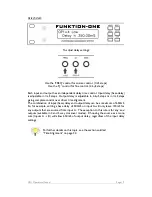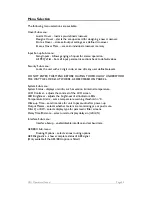
Page 32
XO1 Operators Manual
Crossover Filter Slopes
Please consult the block diagrams on page 11 for details of the various configurations
available. All crossover modes feature adjustable crossover frequencies with a choice
of slopes, 5 bands of driver compensation E.Q. per output and delay time plus
limiters for each output. A powerful 8 band parametric equaliser is also provided on
each input for room equalisation. Phase reverse is provided for each output.
A choice of Bessel or Butterworth slopes at 12/18/24dB per octave and Linkwitz-
Riley at 24dB per octave are provided. Since Low and High pass functions are
separately adjusted, asymmetric slopes are easily achieved, if required. It should also
be noted that the turnover frequency displayed on the XO1 is the -3dB point for all
slopes except 24dB Linkwitz-Riley where the -6dB point is shown. If the -6dB point is
to be used for the Bessel or Butterworth filter, take the required crossover
frequency, multiply this by the appropriate factor from the following table and then
select the closest available frequency on the XO1's display.
Filter Type
High pass factors
Low pass factors
Bessel 12dB/Oct.
1.45
0.69
Butterworth 12dB/Oct. 1.31
0.76
Bessel 18dB/Oct.
1.37
0.73
Butterworth 18dB/Oct. 1.19
0.84
Bessel 24dB/Oct.
1.35
0.74
Butterworth 24dB/Oct. 1.15
0.87
Please note that unlike conventional analogue crossovers, crossover points and slopes
are set with absolute accuracy since component tolerance problems do not occur.
Time Alignment
A further advantage of the XO1 over conventional products is the provision of an
independently adjustable delay section for each output. This allows the true arrival
time from multiple drivers to precisely aligned rather than relying on the compromise
'phase adjust' approach. Delay time is adjustable in 2
.
6
P
S steps (1mm).
Please see page 19 for details of how to adjust the delay times.
To convert from units of time (i.e. milliseconds) to units of distance use the following
formula:
1 millisecond = 343mm (1.126ft) @ 20
°
C (68
°
F)
To calculate time delay for a known distance, use:
Time delay = Distance in meters
20.06 x
273+
q
C
where
q
C is the temperature in
q
C.
To simplify this equation at 20
q
C.
Delay time in milliseconds =
(Distance in meters x 2.192) or (Distance in feet x 0.955)
Note: Centigrade = (Fahrenheit –32) x 0.5555.










































